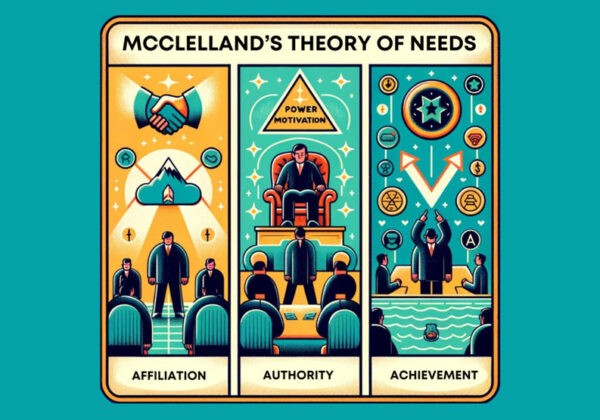🏢 9,000+ Organisations
🏆 6 x L&D/HR Awards
⭐ 4.8/5 Highly Rated
🧠 24 Years' Experience

McClelland’s Theory of Needs has revolutionised how organisations perceive and address motivation.
Rooted in the intricate dynamics of affiliation, authority, and achievement, this theory provides invaluable insights for today’s leaders.
Often incorporated into comprehensive management training, understanding and applying this theory is crucial for creating a motivated and high-performing workplace.
Let’s take a look into the essence of McClelland’s groundbreaking work, and its practical implications for modern management!

David McClelland was an American professor at Wesleyan University and Harvard in the United States before he died in 1998.
While at Harvard, he spent more than 20 years studying the way people are motivated and how they address their achievements and needs. After years of research, he published a book called The Achieving Society, in which he discussed the three types of motivational needs he had discovered:
McClelland found that everyone, regardless of their level in the workplace, experiences all three of these needs on some level – whether they need to motivate others or be motivated themselves.
However, they also spend most of their time leaning more towards one. The type of motivation a person leans towards most will determine what type of worker or manager they will become.
David McClelland’s theory of needs is based on the Theory of Human Motivation developed by Abraham Maslow. Maslow used this theory to create his Hierarchy of Needs, a pyramid that starts with basic needs like food, water, and shelter and ends with self-actualisation and the ability to reach one’s highest potential.
McClelland’s theory takes Maslow’s theory a step further and explores the specific motivations that can help people reach self-actualisation.
McClelland’s theory of needs identifies three primary types of emotional needs, all of which are explained in more detail below:
If a person has a motivational need for affiliation, that means they’re motivated by their connections with others. They strive for strong interpersonal relationships and deep emotional connections.
People who are driven by this type of motivation often prefer working with others instead of working alone. They care about being liked and tend to avoid situations that could lead to rejection or cause conflict within their relationships. They generally dislike uncertainty and high-risk scenarios as well.
If someone has a motivational need for authority or power, they are driven by a desire for control and authority over others. These individuals tend to seek out leadership positions and opportunities in which they can be the primary decision-makers.
Power-motivated people often enjoy competition and spirited debates. They don’t avoid high-risk situations, either. In fact, they seek out these situations and view them as opportunities to show off their skills and gain recognition from others.
Those who lean toward power motivation can often be divided into two additional groups: institutional and personal.
People with a need for institutional power like to organise team efforts to reach company or organisational goals. People with a need for personal power, on the other hand, like to have a sense of control over others.
A motivational need for achievement means a person is motivated by completing tasks – either those they have set for themselves or those that someone else has set for them.
Achievement-motivated people tend to seek out opportunities to highlight their skills, and they don’t like performing tasks that are either too simple or too complex. They don’t mind stepping outside of their comfort zone and trying something new, but they also don’t want to go too far.
Unlike affiliation-motivated individuals, achievement-motivated people often like to work alone. However, they appreciate feedback on their work and want to make sure they’re on the right track.

McClelland’s theory is most often applied in business and corporate settings. By understanding what motivates different employees, employers can adjust their approach to cater to people’s unique needs and produce better outcomes.
Initially, it can be difficult for those in leadership roles to find ways to harness each person’s motivational needs. The more you understand about each need, though, the easier it is.
The following are some examples of how a leader might leverage employees’ individual motivational needs to achieve organisational goals and move the company forward:
People with a high achievement drive often desire to set and achieve challenging goals. These people often excel in professional settings because of their ability to focus on their goals and exercise traits like self-discipline, personal responsibility, and punctuality to accomplish them.
A manager or other leader could harness these employees’ motivation needs by giving them specific feedback on their results. Achievement-motivated people like to know how they’re doing, and receiving regular feedback will help to keep them focused on completing tasks and projects.
It’s important for leaders to note, though, that achievement-motivated people often struggle to work in teams because of their high standards and highly competitive nature. It may be better to lean into this preference instead of trying to shoehorn them into group work.
People with a high affiliation drive tend to prefer social situations and seek harmony between themselves and others (including their colleagues, managers, etc.).
To harness these motivational needs, a leader should give affiliation-motivated individuals opportunities to collaborate with others. These people can also play a critical role in uplifting the company culture and boosting the team’s morale.
When talking with affiliation-motivated people and offering feedback, managers should take care to be patient and kind (without sacrificing clarity and directness, of course).
These individuals tend to fear rejection and may take criticism more harshly than others, so it’s essential to watch your delivery when communicating with them. Understanding the different communication styles is key here, for helping to improve your communication skills and enhance your workplace relationships.
People with strong authority motivation needs can be very charismatic and may make good leaders or project managers. This is especially true of those who have a socialised power motivational need, as these individuals are often highly driven to help the company or organisation grow and achieve its goals.
Managers and team leaders can harness a person’s authority motivation by appointing them to leadership roles and giving them opportunities to achieve their unique goals. They should also be direct with these people when providing feedback so that they know when they need to reign in their tendencies to be controlling or overly critical.
Identifying and catering to people’s distinct motivational needs can help employers, department heads, and others in leadership positions make more progress toward their goals. They can also maximise employees’ productivity and put them in situations where they are likely to thrive and make decisions that best benefit the company.
In addition to tailoring communication methods, task assignments, and feedback to people’s motivational needs, employers can also set their team members up for success by cultivating a motivational environment. The following are some tips that can help with this:
The first step to creating a more motivational environment at your company or among your team is to acknowledge and appreciate everyone’s individuality. When you recognise and respect that all team members have different strengths and weaknesses, you help them feel accepted and valued for who they are instead of what they think they need to be.
It’s also important to be flexible in how you engage with different employees and how you allow them to do their work. For example, some employees may work better when they have opportunities to work closely with others in pairs or groups, whereas others prefer to work independently.
Allow people to use their strengths and work in the ways that are best for them as much as possible. That will boost motivation and lead to better morale and increased productivity.
In addition to acknowledging people’s existing strengths and skills, it’s also helpful to offer ongoing training and professional development opportunities that empower them to improve their current skill sets and acquire new ones.
When you show a commitment to your employees’ training and education, you show that you care about them and want them to gain the skills and knowledge they need to succeed.
It’s easier to create a motivational environment when you have open lines of communication with everyone on your team (and they have open lines of communication with each other). When you create a workplace where open communication is the norm, you make it easier for people to identify and express their needs (and take the steps required to ensure they get met).
Remember that you can create open communication even among remote employees. Utilise communication platforms and chat apps to keep everyone connected no matter how far apart they’re located from each other.
Employees will feel safe and motivated in the workplace when you strive to be reliable and consistent. Be a reliable resource they can turn to when they need guidance, feedback, or support, and be consistent in how you communicate, how you approach conflict, etc.
If you need some support in managing conflict, check out our article: How To Manage A Conflict Within Your Team.
McClelland developed his Theory of Needs at Work several decades ago. However, it still remains a popular option among leaders and is often chosen over other workplace motivation theories.
Implementing McClelland’s workplace motivation theories requires some extra upfront work on the manager or employer’s part. However, in the long run, these efforts will pay off as employees maintain high productivity levels and achieve their goals.
These steps can help managers and leaders utilise McClelland’s theories of motivation in the workplace:
Start by clarifying the unique drivers of each of your employees. There are a few ways you can do this, including the following:
Here are some questions you might ask to help you determine each person’s primary driver:
When evaluating people’s answers, keep in mind that everyone has all three motivational needs and is driven by each of them at different points. However, the goal is to find the motivational need that drives them most often.
After you find out what makes your employees tick, it’s time to make plans to motivate each of them. For example, you might decide to assign challenging assignments to your achievement-driven team members and give authority-motivated individuals opportunities to lead and delegate tasks.
Next, it’s time to implement those processes and plans you came up with in the previous step. When you’re meeting with your team or making plans for the upcoming week, look for ways to help team members meet their motivational needs.
Even if those needs can’t be met at all times during the day, they should still have opportunities regularly to exercise their strengths.
Observe your employees in their various roles and, as needed, give people feedback on how they’re doing, how they can improve, etc. It’s imperative to provide feedback to achievement-driven employees so they can stay motivated and feel confident that they’re making progress toward their goals.
By the same token, you should also be willing to receive feedback from your employees. If someone feels that their needs aren’t being met and they’re struggling to stay engaged or be as productive as possible during the workday, you need to know so you can adjust your plan and empower them to be their best.
No plan is perfect from day one. It takes regular evaluation and adjustment to make your plans and processes as effective as possible.
Don’t be afraid of pivoting if an element of your plan isn’t working. Remember, the goal is to set your employees up for success by fulfilling their motivational needs, and it’s okay to make changes to ensure that happens.

Some people have a hard time recognising and nurturing employee motivational needs – not everyone fits neatly into a single category, after all. If you’re part of this group, you can reference these McClelland’s theory of needs examples to get a better sense of how each motivational need looks in action:
An employee who is achievement-motivated will be more likely to seek out tangible rewards, such as a raise or promotion, for their hard work. They might want to meet with you to discuss the steps they need to take to achieve those goals and continue progressing in their careers.
You’ll often see achievement-motivated individuals working toward and successfully occupying lower-level management positions. These positions are challenging enough to keep them motivated, but they’re not as difficult as higher-level management and executive roles.
Affiliation-driven employees are generally the most social people in your office. You will see them collaborating with others, making sure team members feel seen and heard, and encouraging their colleagues.
People motivated by affiliation typically don’t seek out power or leadership positions. However, they can act as good intermediaries between achievement- and authority-driven individuals, creating more uplifting work environments and encouraging stronger relationships.
People who are driven by a need for authority and power will often strive for leadership positions and opportunities to control situations, make decisions, delegate assignments, etc. They will seek recognition for their hard work and accomplishments, too.
You will often see authority-motivated people in leadership roles. They’re often well-suited to these positions because of their affinity for risk-taking and their willingness to take responsibility if things don’t work out.
Understanding what motivates each of your employees, as well as how to implement McClelland’s motivation theories in the workplace, can help you become a more effective leader and produce better outcomes for your team and the entire company.
Helping employees understand whether they’re primarily motivated by achievement, affiliation, or authority can also help them know themselves better and lean into their unique skills and abilities instead of continuously trying to fit themselves into a different mould.
Use the suggestions and tips shared above to get to know your employees better and tailor your leadership style to their specific motivational needs.
Need help assessing your employees and identifying their other strengths and learning styles?
MTD has a variety of Management Training Courses for you to choose from like our open course Management Skills Training, Leadership Development Programme and Team Leader Training Course.
Get in touch today to find out more.

Written by Sean McPheat
CEO of MTD Training and Amazon bestselling author. Sean writes about leadership, business, and personal growth, drawing on 20+ years of experience helping over 9,000 companies improve performance.
Updated on: 16 April, 2024
Originally posted: 16 November, 2009
Related Articles

Search For More 